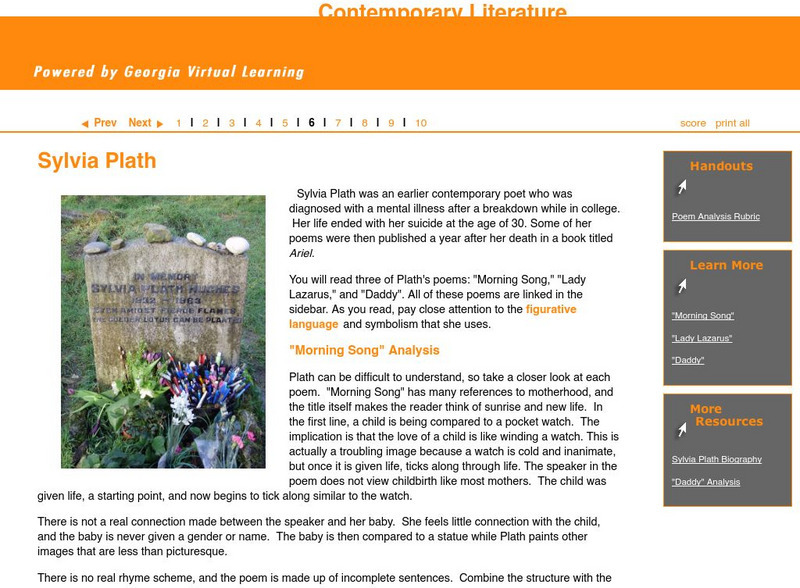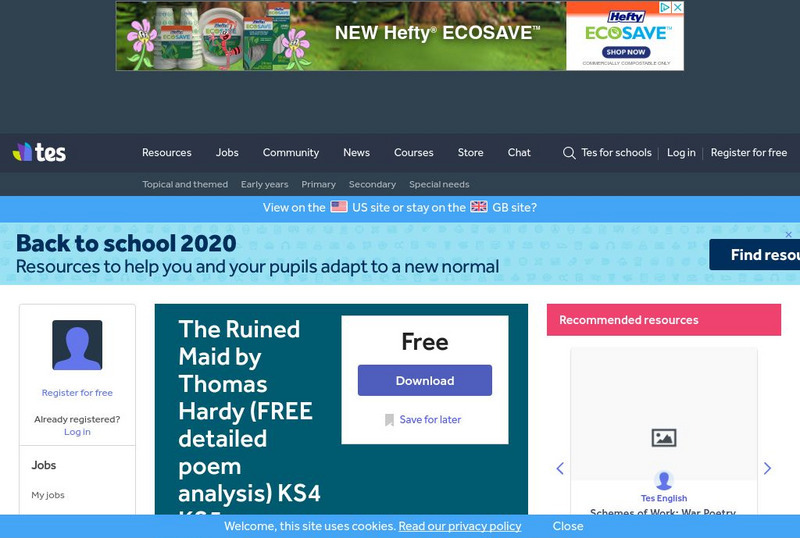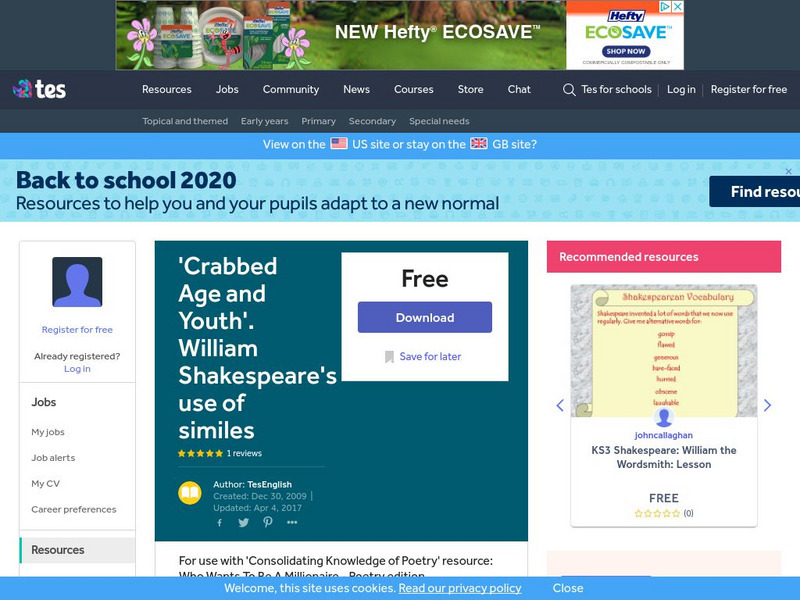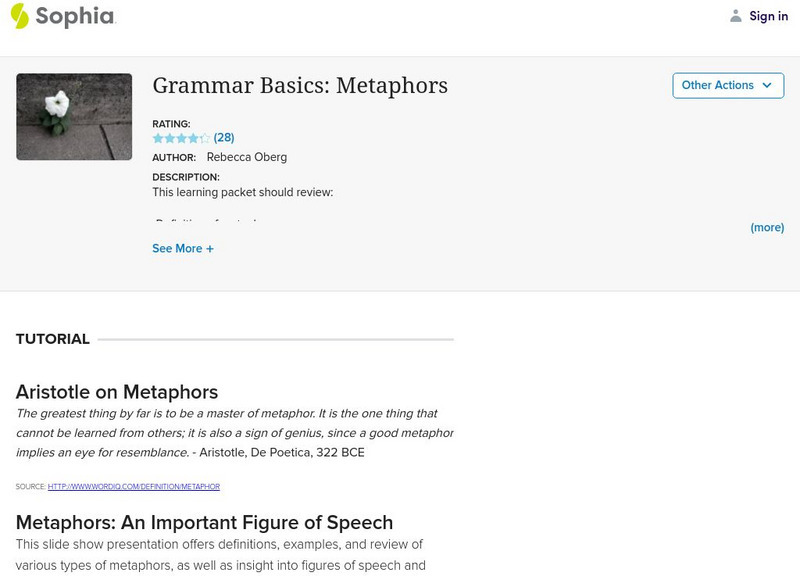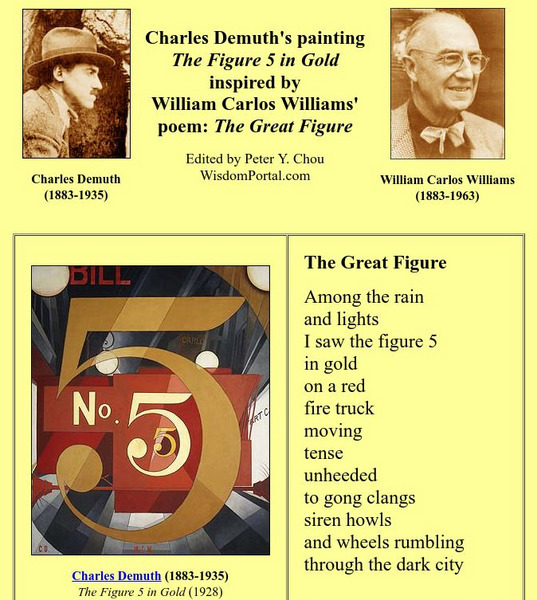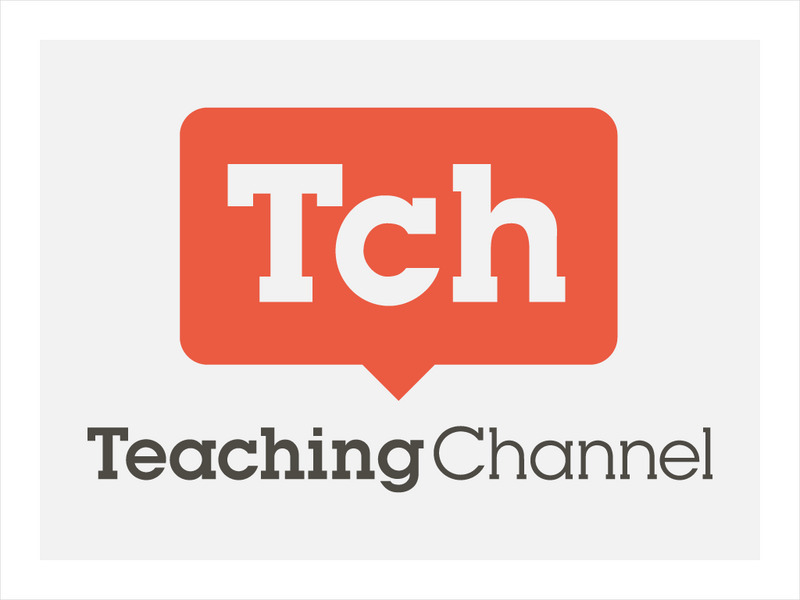Georgia Department of Education
Ga Virtual Learning: "Top Twenty Figures of Speech" [Pdf]
This is a two-page PDF of the "Top Twenty Figures of Speech" which provides 20 literary techniques with their definitions from GrammarAbout.com.
Other
Blinn College: Bryan Writing Center: Poetry Explication [Pdf]
Provides guidelines for analyzing poetry. Students must make certain they have a basic understanding of a poem, then analyze the language used. A set of 26 questions is offered that students can reference to help them analyze a poem....
Georgia Department of Education
Ga Virtual Learning: The Elements of Poetry [Pdf]
This is a 2-page PDF of a chart that lists eight elements of poetry, questions to ask concerning each element, and tips and explanations to aid the understanding of each element. RL.9-10.5 text structure effects
E Reading Worksheets
E Reading Worksheets: Differentiated Reading Instruction Worksheets, Activities
A collection of differentiated reading activities are provided in this collection. Worksheets for the following reading topics are included: climax, story structure, elements of a story; fact and opinion; summarizing, narrative sequence;...
Texas Education Agency
Texas Gateway: Literary Text: Close Reading of Poetry: Practice 3
This lesson will help you comprehend the poet's meaning by giving you practice in finding imagery, metaphors, symbolism, and allusions.
Read Works
Read Works: Wonderful Trees
[Free Registration/Login Required] A poem about trees by Arin Lapa. A question sheet is available to help students build skills in reading comprehension.
Other
Frost Friends: Robert Frost
This webpage provides a brief biography of Robert Frost and links to all of Frost's poems and quotes.
TES Global
Tes: Romeo & Juliet: Parent & Child Relationships
[Free Registration/Login Required] This extensive lesson focuses on the parent/child relationships in Romeo and Juliet and in Ben Jonson's poem "On My First Sonne." Several activities are provided to aid students in comparing the...
Read Works
Read Works: 4th Grade Lesson: Similes and Metaphors
[Free Registration/Login Required] A lesson in which students use the book Poetry for Young People: Langston Hughes edited by David Roessel and Arnold Rampersad to learn to identify and understand the use of simile and metaphor in...
Georgia Department of Education
Ga Virtual Learning: Contemporary Literature: The Modern Poet: Sylvia Plath
This lesson focuses on Sylvia Plath, her poetry, and how to analyze a poem. It features links to her biography; three of her poems: "Morning Song," "Lady Lazarus," and "Daddy"; an analysis of "Daddy"; and a poem anlaysis rubric. Students...
TES Global
Tes: The Ruined Maid by Thomas Hardy
[Free Registration/Login Required] This Power Point presentation provides a detailed poetic analysis of Thomas Hardy's poem titled 'The Ruined Maid.' Close analysis of the poem's language and imagery are featured.
Texas Education Agency
Texas Gateway: Paradox (English Iii Reading)
Source: Paradoxes, James Guppy, Flickr Paradox is a type of figurative language that A Handbook to Literature defines as "a statement that while seemingly contradictory or absurd may actually be well-founded or true." You will find...
PBS
Pbs Learning Media: Literary Elements and Techniques Collection
These animated shorts introduce or review literary elements and techniques like theme, setting, figurative language, characterization, and conflict. They can be used when students are just learning how to identify the most commonly used...
TES Global
Tes: 'Crabbed Age and Youth'. William Shakespeare's Use of Similes
[Free Registration/Login Required] This learning module contains a PowerPoint game that reviews literary and figurative elements that are present in poetry. Students will also analyze the William Shakespeare's poem, "Crabbed Age of...
Sophia Learning
Sophia: Grammar Basics: Metaphors
Learn about similes and metaphors through this multimedia presentation. First view a slide show describing different types of metaphors as well as a simile. Then watch a video [3:13] showing similes and metaphors used in popular songs. A...
Love To Know Media
Your Dictionary: Literary Terms Lesson Plan
This is a lesson plan for teaching the seven literary terms used in poetry: simile, metaphor, alliteration, imagery, hyperbole, personification, and onomatopoeia.
ArtsNow
Arts Now Learning: Moon Phaser [Pdf]
In this activity, 4th graders will study the moon for a period of one month and learn to identify each major moon phase. They will then describe the moon through poems, haikus, and similes.
Love To Know Media
Your Dictionary: Poetry Lesson Plans Onomatopoeia
This site offers a definition of onomatopoeia and two lesson plans with two activities each for teaching onomatopoeia to 9th graders.
Writing Fix
Writing Fix: Between Repeated Lines
In this lesson plan young scholars will write a poem about someone they love after they have brainstormed an original idea.
Other
The Quotations Page: Lord Alfred Tennyson
Students and teachers will benefit from these examples of quotes from Lord Alfred Tennyson. This site offers only a handful of examples. Don't miss out.
Texas Education Agency
Texas Gateway: Understanding and Analysis of Literary Text: Meter and Rhyme
OnTRACK English II Reading, Module 3, Lessons 1-12, and Practice Lessons 1-3. Students understand, make inferences and draw conclusions about the structure and elements of poetry, drama, fiction, and literary non-fiction, and provide...
Other
The Figure 5 in Gold: Charles Demuth's Art & William Carlos Williams' Poem
The inspiration for Charles Demuth's painting was a poem entitled 'The Great Figure.' Learn about the connection between the artwork and the piece of literature.
Utah Education Network
Uen: Discovering Ourselves in Literature and Life
This lesson plan, provided by the International Society for Technology in Education (ISTE), encourages students to evaluate literature in a variety of multimedia formats and answer the question, "Who Am I?," Students are then asked to...
Teaching Channel
Teaching Channel: Exploring Poetic Elements
This is a teacher demonstrating and discussing teaching students poetic elements: learning the literary terms, their definitions, and how to apply the information when analyzing poetry.


![Ga Virtual Learning: "Top Twenty Figures of Speech" [Pdf] Unit Plan Ga Virtual Learning: "Top Twenty Figures of Speech" [Pdf] Unit Plan](https://d15y2dacu3jp90.cloudfront.net/images/attachment_defaults/resource/large/FPO-knovation.png)





